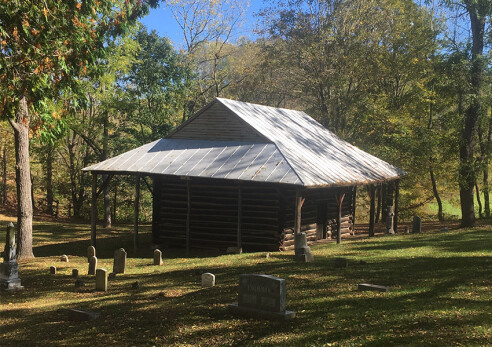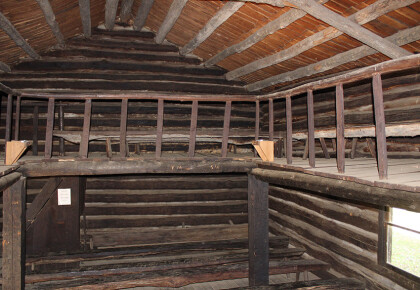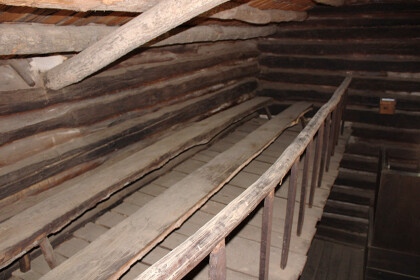Traveling the Circuit: Rehoboth Church and Museum
By Rev. Charles Harrell

Edward Keenan’s conversion to the warm-hearted religion of the Methodists occurred about twenty miles away from the picturesque hollow where Old Rehoboth Church has sat for more than two hundred years. Keenan, a Roman Catholic immigrant from Ireland who had long been well-disposed toward the Methodists, was riding with his friend and Methodist preacher John Smith on Potts Mountain in what today is the border country between the Virginias. A short time later in the adjoining valley, Smith baptized Keenan. Returning home, Edward found that his wife Nancy and her mother were none too pleased with the change in his religious persuasion; and when after a short time a Methodist society began meeting in the Keenan home, the women silently busied themselves with embroidery or other tasks while the “heretical” singing and exhorting was going on around them. Yet eventually they, too, felt the stirring of the Holy Spirit moving them to embrace personal faith in the tradition of the Wesleys. Today, Rehoboth Church is the most visible sign of the transformation God worked in their lives.
On
James Christie, recognized today as the founding
Today Rehoboth Church is the oldest Protestant house of worship of any kind still remaining west of the Alleghany Mountains. Though Bishop Asbury’s journal shows that he was not, as local legend holds, present for the dedication of the building in 1786, he did visit on five occasions between 1788 and 1797. During the first of these visits, in July of 1788, he preached and ordained John Smith as a deacon, the first Methodist ordination west of the Alleghenies. Anytime Asbury came, he would bring along one of the renowned Methodist preachers of his day, such as when Richard Whatcoat accompanied him on his third visit.

Measuring just 21 feet by 29 feet, the old church is tiny even by the standards of very small church buildings in our day; still, it was about double the size of the log cabin homes in the area at the time of its construction. It bears the telltale marks of its era: support beams running the length of the building, wood shingles (the current ones being reproductions), and the use of puncheons for interior surfaces and seating. A raised pulpit (again, a reproduction) sits on one end of the single interior room, and a gallery above affords additional seating.
When Rehoboth was built, Greenbrier County (from which today’s Monroe County would later be formed) was on the frontier, and skirmishes with “Indians” were a continual worry in the settlers’ minds. Consequently, the whole church sits in a swale within a small hollow of land. This so-called “reverse slope defense” allowed for those in the church to see raiders coming from some distance away. The upper gallery of the church contained gunports (since filled in), and the men and boys sat above, with the women and girls below. As Anita Tracy, the current caretaker of the site, says: “We Methodists are not proud of how we treated our native brothers and sisters – but it is history.” The same concern about security prevented the installation of a stove that emitted smoke outside. In later decades, after worries about safety had passed, the gallery was used as seating for enslaved black congregants. As Tracy is quick to point out, that also is not something United Methodists are proud of today.
Another detail of the period construction is the door hinging system, which uses augured openings and wood pegs rather than metal hinges, and is believed to be original. Unknown is whether the church originally had a wooden or dirt floor, though a decayed wooden floor had to be removed during the 1920's restoration.
In its early decades, Rehoboth hosted weekend services and revival meetings for which families would arrive on Saturday night. The doors of the church opened at 7:00 a.m. on Sunday. Services would begin, and preaching would continue until 12:30 in the afternoon or until the preacher got hungry. Then there would be a break for a midday dinner, after which preaching and exhortation would continue until late in the day. No one slept during the sermons: there was shouting and stomping, and if someone happened to nod off, a steward with a “prompter” pole would nudge the delinquent worshiper awake once more. Often the crowds were large enough that not everyone could fit inside. The preacher would then stand in the open doorway, and proclaim the word to those inside and outside at the same time, or by turns.
Along with land for the building itself, Keenan had included property for a cemetery, which surrounds the church on three sides, including burials dating from 1807 to 1947. Approaching from the modern parking lot, the mortal remains of Edward and Nancy Keenan rest just beyond the church building. Three Revolutionary War veterans and one from the War of 1812 are among the graves, which also include those of several Confederate veterans of the Civil War. (West Virginia was created out of Virginia and admitted to the Union in 1863, but in the border counties, including Monroe,

At the church’s dedication in 1786, Edward Keenan said, “As long as the grass grows and the water flows, this shall be a place of worship.” By the middle of the next century, however, the congregation had outgrown the original building, and a new church was built a little upslope in 1871. This building, whose official name was apparently “St. John” but was known to all locally as “Central Church”, was larger and sported four windows and a stove, and was affiliated with the Methodist Episcopal Church, South. Now unused, the original log cabin structure suffered from neglect and fell into disrepair. A complete restoration project began in 1927, and workers added a tin roof canopy as a protective shelter for the historic building in 1930. During the following decade, Central Church burned down and was not rebuilt.
As the decades passed, the recognition of Rehoboth’s importance as a heritage site, for the history both of Methodism and of West Virginia, has only grown. In 1939 it was the scene of a special service commemorating the uniting of the Methodist Episcopal Church, Methodist Episcopal Church, South, and Methodist Protestant Church to form The Methodist Church, which in 1960 designated Rehoboth one of the first 17 Methodist Historic Shrines. Today, it is one of 49 United Methodist Heritage
The year 1978 saw the addition to the site of a small museum of modern design, which was dedicated by Bishop D. Frederick Wertz. The museum contains exhibits relating both United Methodist
The museum also contains two portraits of noteworthy Methodists from the area. One is of Bishop Matthew Wesley Clair, Sr. (1865-1943), one of the first two black bishops in the Methodist Episcopal Church and later The Methodist Church, who was born nearby. A state historic marker at the intersection of West Virginia Route 3 and 2nd Street in Union marks the site. Bishop Clair’s first appointment was at Harper’s Ferry; he was also responsible for the rebuilding and enlargement of the present Asbury United Methodist Church at 11th and K Streets, NW, in Washington, D.C., in 1915. Clair Memorial United Methodist Church in Omaha, Nebraska, is also named in his honor. He is buried in Washington, D.C.
Also present is a photograph of Gaye Hoke (1889-1938), one of the first two deaconesses in Methodism, who was also a native of Monroe County and is buried at Lewisburg.
Today in addition to tours, Rehoboth hosts special services, weddings, reunions, and church picnics. A multi-purpose room in the museum, affording a lovely view of the old church, offers a good venue for retreats, meetings, or confirmation groups to gather. The ministry of the center today is open to
Rehoboth Church is located at 186 Old Rehoboth Church Road, Union, WV 24983. To get there, follow U.S. Route 219 (Seneca Trail) to Union, then West Virginia Highway 3 about two miles east to Rehoboth Church Road. A historic marker and sign will direct you down the road about 1/4 mile to the church site. (Driving time with normal traffic from most points in the Baltimore-Washington Conference is 4.5 to 5.5 hours.) It is open from April to October, Thursdays through Saturdays 11:00 a.m. - 5:00 p.m., and Sundays 1:00 - 5:00 p.m., or by appointment. Admission is free, but donations are gladly accepted. Contact Anita Tracy at (304) 389-8840, or by e-mail at for more information or to arrange a group tour.
Accommodations: Union is about ½ hour from Lewisburg or White Sulfur Springs (to the north), or the Sweet Springs Resort (to the east). Also to the east, about 12 miles on Highway 3, is the town of Gap Mills, with its Mennonite-operated “Cheese ‘n’ More” grocery, bakery, and furniture store.
There are several choices for food in the area. Union’s offerings include the Corner Café, the Kalico Kitchen, and the more upscale Hall Tavern. Farther afield, the Swinging Bridge Restaurant in Point Bank, Virginia (about 45 minutes east) is famous for its bison burgers.
I enjoyed a meal at the specially-recommended Nanny’s Café, right along Main Street (US 219) near the big curve at the north end of town. Nanny’s is open from 6:00 a.m. to 2:00 p.m, and is owned by Todd and Korie Baker. (Todd is also the pastor of the local independent Baptist church.) It is known for its baked goods, sandwiches, and unusual specials, and features locally-sourced jams and jellies. The day I was there, the midday offering was called “Dorm Lunch”: pizza left from an event the night before. But it was not like anything like I ever had in the dorm: delicious brie with bacon, and spinach with artichoke, among others. I enjoyed a couple of slices with a small bowl of curried pumpkin soup – delicious!
Though a bit off the beaten path, Rehoboth Church amply rewards the traveler who makes the pilgrimage. And old Edward Keenan must have been on to something; for the grass still grows, the water still flows, and Rehoboth Church still stands sentinel in the “Sinks of Greenbrier” as a witness to the Methodist past, and a legacy for years yet to come.
Rev. Charles L. Harrell, Ph.D., is a retired elder in the Baltimore-Washington Conference. When not working at his day job as Director of Pastoral Care for a fabulous area retirement community or teaching in the field of history and doctrine at one of our United Methodist seminaries, he can often be found poking around sites of historical or cultural interest. His not-so-hidden agenda is to incite or fan a similar flame of appreciation for our heritage in faith and its gifts and promise for blessing now and tomorrow.
